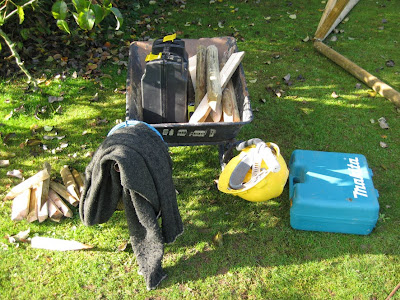The cover has come off the limecrete slab and around 20 bales of damp straw fluff removed. All looks OK underneath
I found a source of "SmartPly" OSB, reckoned to be preferable to the standard grade on account of the lower formaldehyde content (Meyer Ltd). I have 16 sheets in the dome for cutting, and 20 under cover for use as the roof deck later.
Cutting corners!
But not in the metaphorical sense. I have been very carefully cutting out square corners from SmartPly sheets to form the corners of the wall plate. Eight of these:
And quite a lot of these straight section, all 450mm wide
It's been very useful having plenty of trestles to support sheets whilst cutting. I made 6 of these from scrap wood during the winter.
Lots of wood arriving: -
It was a day's work to get the wood up the garden near the site and under cover. Quite a big pile outside......
......and plenty more inside:
Also taking up a lot of time over the last couple of weeks has been the brickwork layout for the stem wall. My layout for the limecrete base last year was not very good, producing a not entirely rectangular base. The diagonals are out by 8cm. I have put up new corner guides for the stem wall that are rectangular, but as a result of the earlier error, they don't sit exactly over the base. I have decided that in the long run, this will be better than having the whole building out. I will have to cover up the foot of the stem wall with plants so it doesn't look too odd; it's a 2cm underhang or overhang at the corners.
I've also been doing detailed planning of the ashlar - the brick corners and pillars that are used in flint walls.
I've built each one up with dry bricks, photographed it course by course, and produced a plan
I felt the need to do this because it gives me one thing less to think about when I am laying the bricks.








































































